Headspace Electronic Health Record (EHR) System: Analysis and Report
VerifiedAdded on 2019/11/26
|12
|1911
|220
Report
AI Summary
This report provides a comprehensive analysis of an Electronic Health Record (EHR) system designed for Headspace, an Australian organization focused on mental health. The report begins with an executive summary and table of contents, followed by an introduction outlining the project's objectives. The core of the report includes a detailed stakeholder map, categorized into internal and external operations and executives, with descriptions of each stakeholder group. A questionnaire developed from the perspective of a business system analyst is presented, along with the identification of stakeholders for its distribution and the questions asked to gather user requirements. The report also includes a use case model and diagrams, describing various use cases such as registration, login, managing accounts, and requesting medical treatments, with a focus on the 'registration' use case as the most critical. The conclusion summarizes the findings, emphasizing the importance of stakeholder analysis and use case diagrams in the development of the EHR system. References to relevant academic sources are provided at the end of the report.
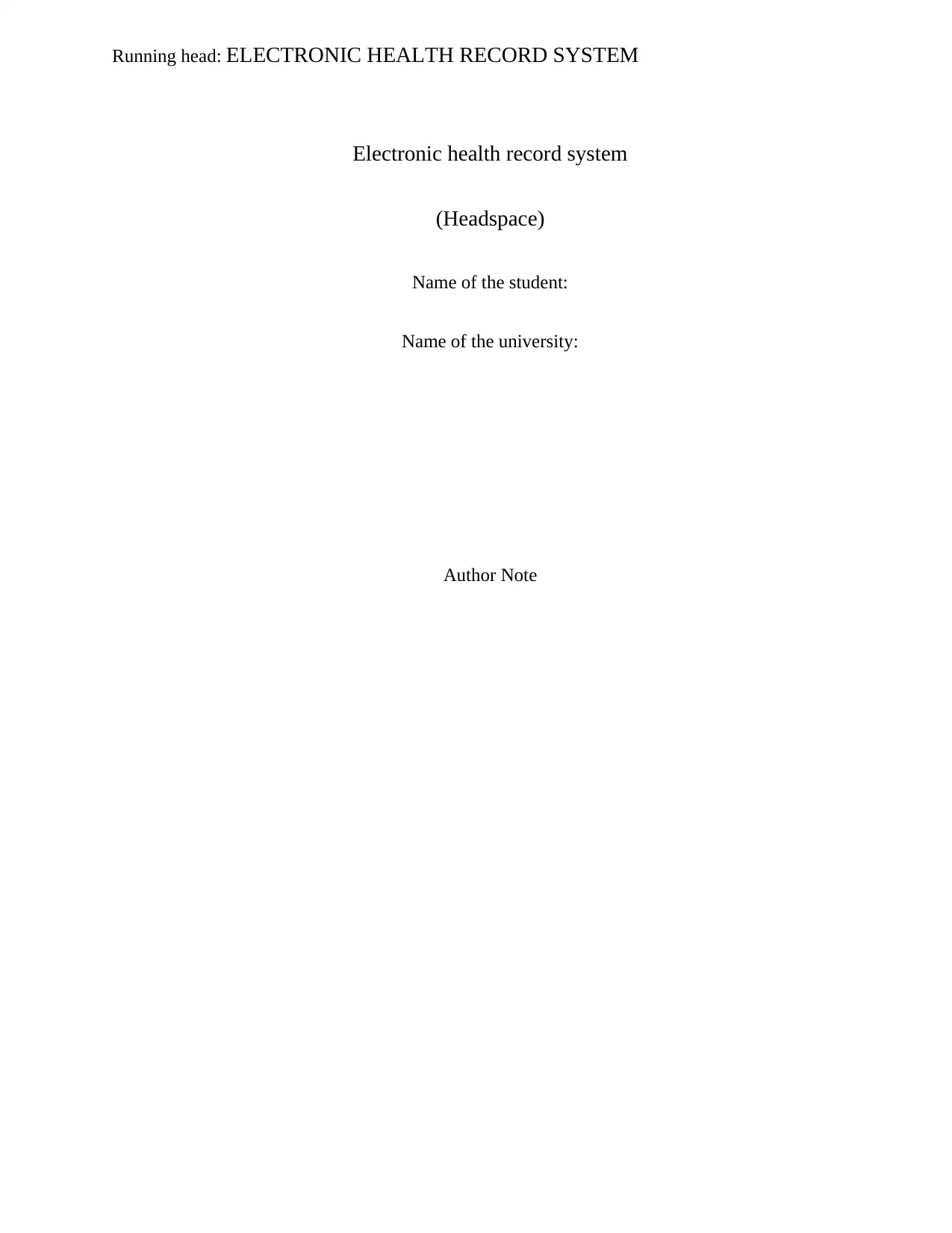
Running head: ELECTRONIC HEALTH RECORD SYSTEM
Electronic health record system
(Headspace)
Name of the student:
Name of the university:
Author Note
Electronic health record system
(Headspace)
Name of the student:
Name of the university:
Author Note
Paraphrase This Document
Need a fresh take? Get an instant paraphrase of this document with our AI Paraphraser

1ELECTRONIC HEALTH RECORD SYSTEM
Executive summary
The report has illustrated the stakeholder maps and questionnaire from the viewpoint of the analyst
of business system at Headspace, Australia. The required use case diagrams are also demonstrated
and described in the report.
Executive summary
The report has illustrated the stakeholder maps and questionnaire from the viewpoint of the analyst
of business system at Headspace, Australia. The required use case diagrams are also demonstrated
and described in the report.
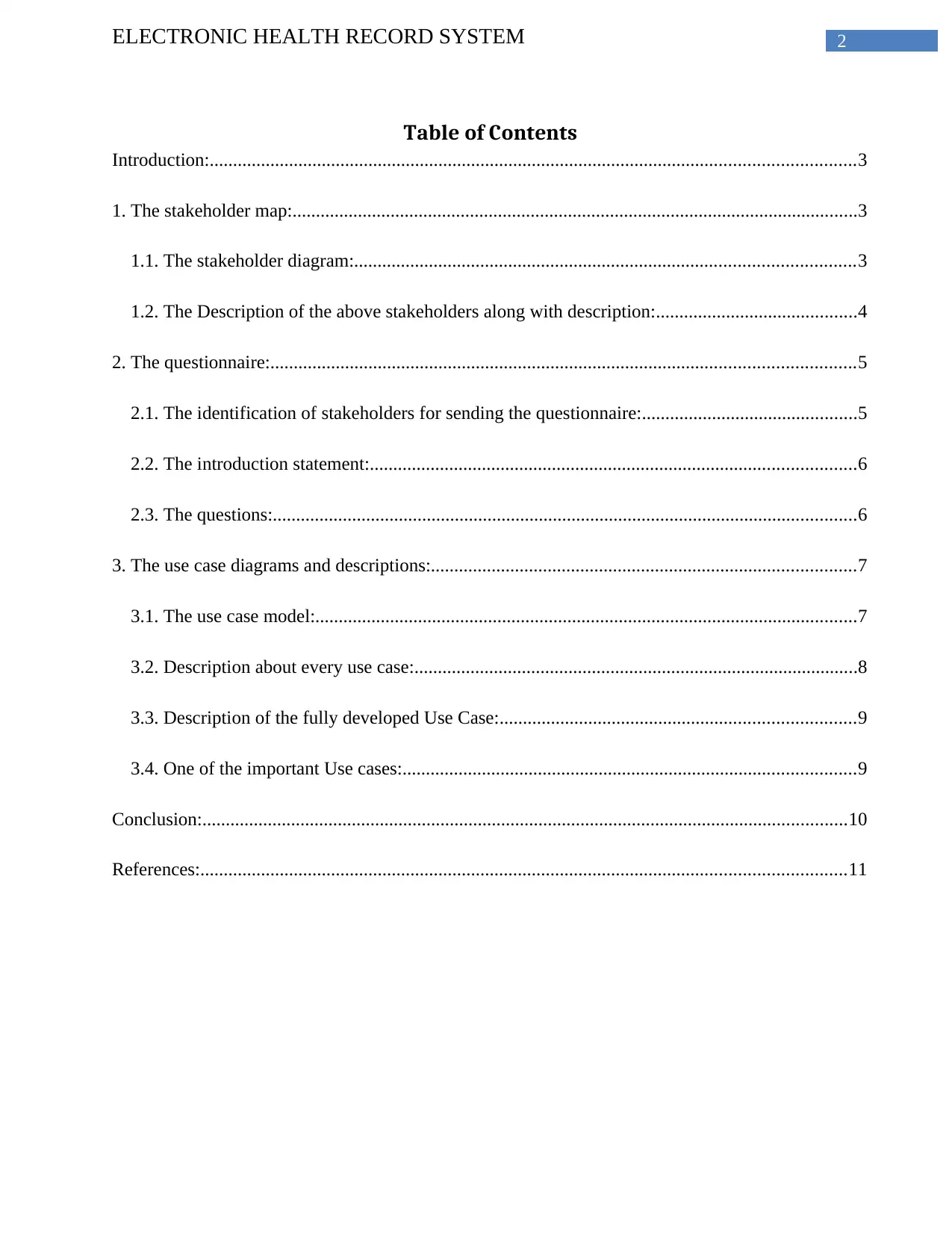
2ELECTRONIC HEALTH RECORD SYSTEM
Table of Contents
Introduction:..........................................................................................................................................3
1. The stakeholder map:.........................................................................................................................3
1.1. The stakeholder diagram:...........................................................................................................3
1.2. The Description of the above stakeholders along with description:...........................................4
2. The questionnaire:.............................................................................................................................5
2.1. The identification of stakeholders for sending the questionnaire:..............................................5
2.2. The introduction statement:........................................................................................................6
2.3. The questions:.............................................................................................................................6
3. The use case diagrams and descriptions:...........................................................................................7
3.1. The use case model:....................................................................................................................7
3.2. Description about every use case:...............................................................................................8
3.3. Description of the fully developed Use Case:............................................................................9
3.4. One of the important Use cases:.................................................................................................9
Conclusion:..........................................................................................................................................10
References:..........................................................................................................................................11
Table of Contents
Introduction:..........................................................................................................................................3
1. The stakeholder map:.........................................................................................................................3
1.1. The stakeholder diagram:...........................................................................................................3
1.2. The Description of the above stakeholders along with description:...........................................4
2. The questionnaire:.............................................................................................................................5
2.1. The identification of stakeholders for sending the questionnaire:..............................................5
2.2. The introduction statement:........................................................................................................6
2.3. The questions:.............................................................................................................................6
3. The use case diagrams and descriptions:...........................................................................................7
3.1. The use case model:....................................................................................................................7
3.2. Description about every use case:...............................................................................................8
3.3. Description of the fully developed Use Case:............................................................................9
3.4. One of the important Use cases:.................................................................................................9
Conclusion:..........................................................................................................................................10
References:..........................................................................................................................................11
⊘ This is a preview!⊘
Do you want full access?
Subscribe today to unlock all pages.

Trusted by 1+ million students worldwide
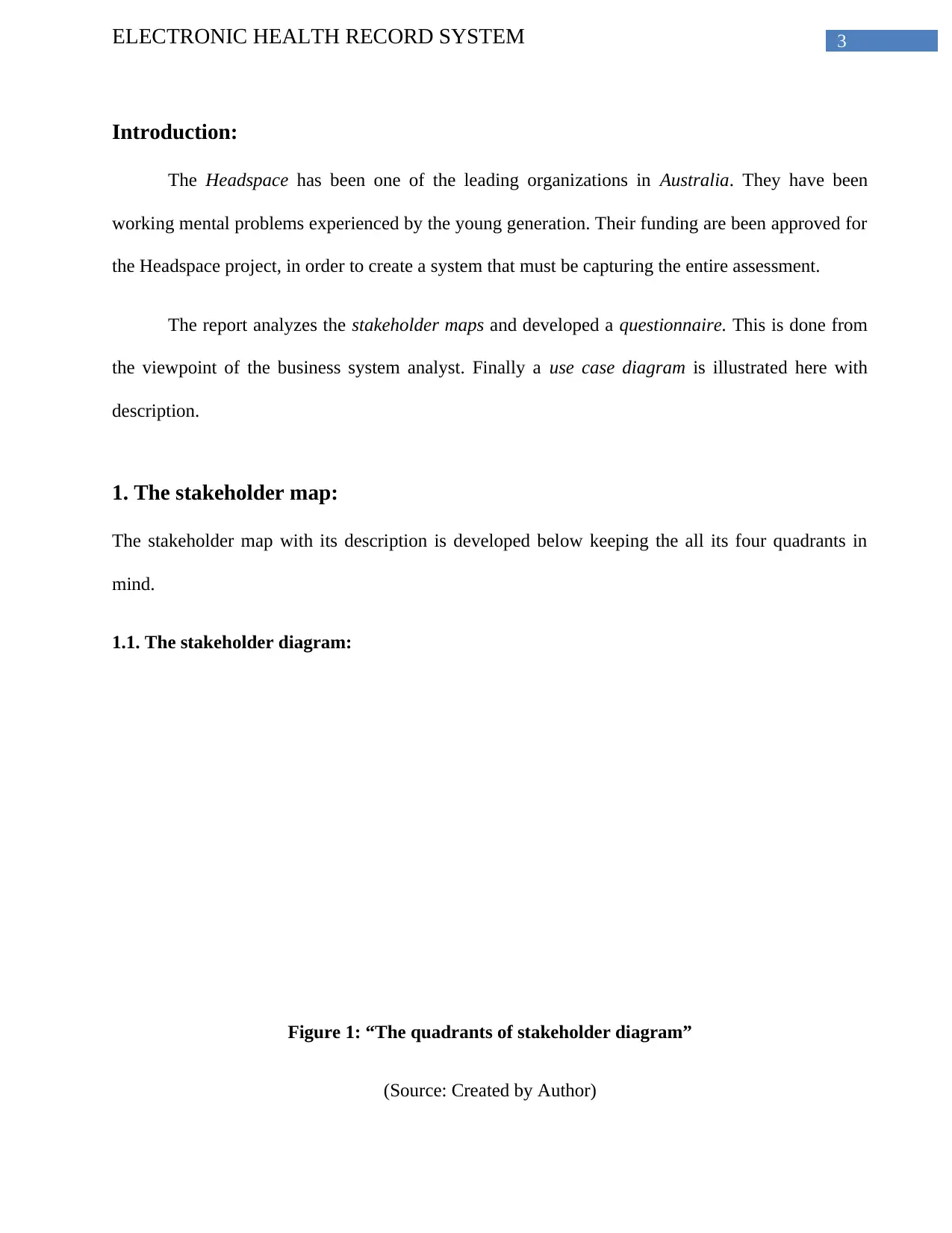
3ELECTRONIC HEALTH RECORD SYSTEM
Introduction:
The Headspace has been one of the leading organizations in Australia. They have been
working mental problems experienced by the young generation. Their funding are been approved for
the Headspace project, in order to create a system that must be capturing the entire assessment.
The report analyzes the stakeholder maps and developed a questionnaire. This is done from
the viewpoint of the business system analyst. Finally a use case diagram is illustrated here with
description.
1. The stakeholder map:
The stakeholder map with its description is developed below keeping the all its four quadrants in
mind.
1.1. The stakeholder diagram:
Figure 1: “The quadrants of stakeholder diagram”
(Source: Created by Author)
Introduction:
The Headspace has been one of the leading organizations in Australia. They have been
working mental problems experienced by the young generation. Their funding are been approved for
the Headspace project, in order to create a system that must be capturing the entire assessment.
The report analyzes the stakeholder maps and developed a questionnaire. This is done from
the viewpoint of the business system analyst. Finally a use case diagram is illustrated here with
description.
1. The stakeholder map:
The stakeholder map with its description is developed below keeping the all its four quadrants in
mind.
1.1. The stakeholder diagram:
Figure 1: “The quadrants of stakeholder diagram”
(Source: Created by Author)
Paraphrase This Document
Need a fresh take? Get an instant paraphrase of this document with our AI Paraphraser
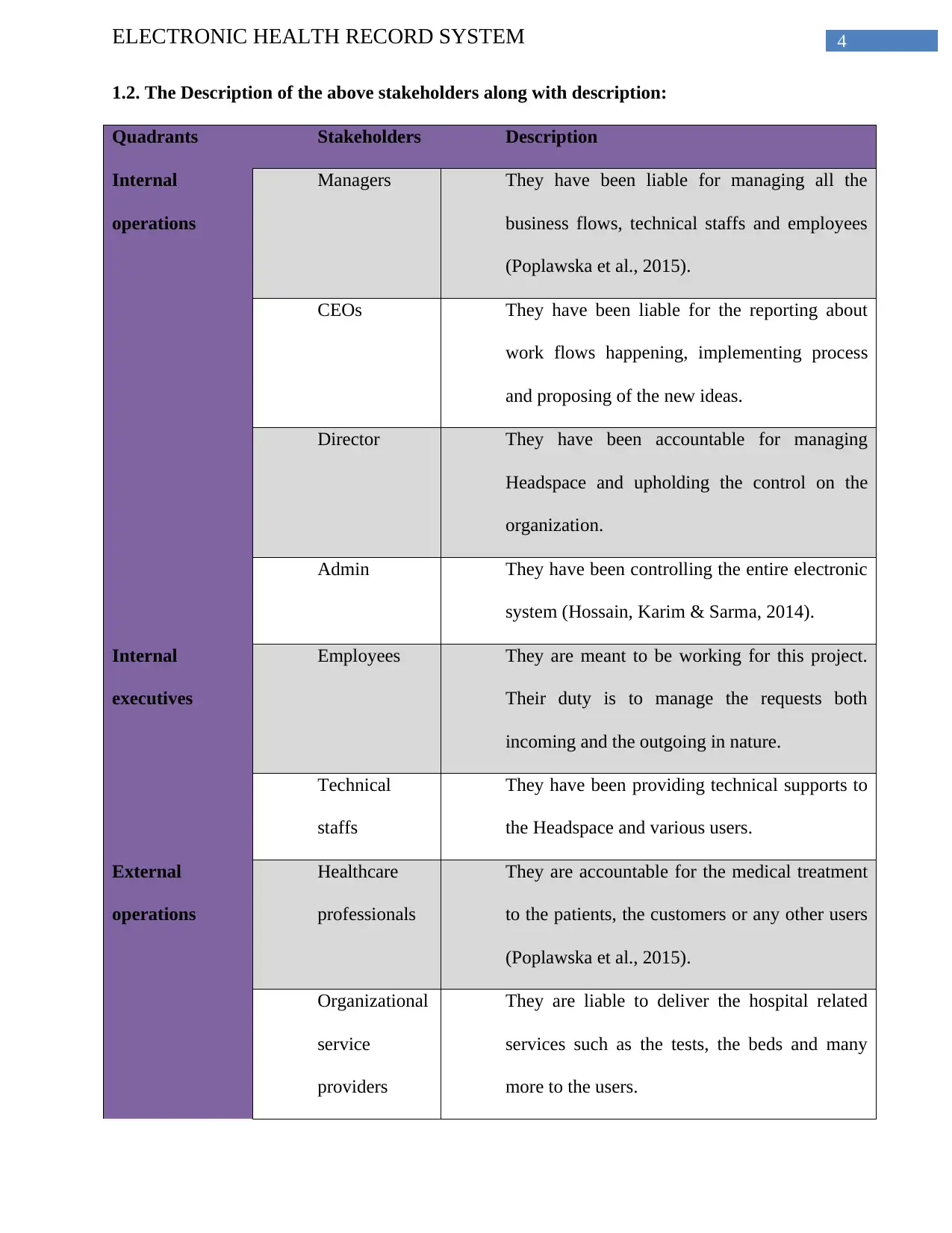
4ELECTRONIC HEALTH RECORD SYSTEM
1.2. The Description of the above stakeholders along with description:
Quadrants Stakeholders Description
Internal
operations
Managers They have been liable for managing all the
business flows, technical staffs and employees
(Poplawska et al., 2015).
CEOs They have been liable for the reporting about
work flows happening, implementing process
and proposing of the new ideas.
Director They have been accountable for managing
Headspace and upholding the control on the
organization.
Admin They have been controlling the entire electronic
system (Hossain, Karim & Sarma, 2014).
Internal
executives
Employees They are meant to be working for this project.
Their duty is to manage the requests both
incoming and the outgoing in nature.
Technical
staffs
They have been providing technical supports to
the Headspace and various users.
External
operations
Healthcare
professionals
They are accountable for the medical treatment
to the patients, the customers or any other users
(Poplawska et al., 2015).
Organizational
service
providers
They are liable to deliver the hospital related
services such as the tests, the beds and many
more to the users.
1.2. The Description of the above stakeholders along with description:
Quadrants Stakeholders Description
Internal
operations
Managers They have been liable for managing all the
business flows, technical staffs and employees
(Poplawska et al., 2015).
CEOs They have been liable for the reporting about
work flows happening, implementing process
and proposing of the new ideas.
Director They have been accountable for managing
Headspace and upholding the control on the
organization.
Admin They have been controlling the entire electronic
system (Hossain, Karim & Sarma, 2014).
Internal
executives
Employees They are meant to be working for this project.
Their duty is to manage the requests both
incoming and the outgoing in nature.
Technical
staffs
They have been providing technical supports to
the Headspace and various users.
External
operations
Healthcare
professionals
They are accountable for the medical treatment
to the patients, the customers or any other users
(Poplawska et al., 2015).
Organizational
service
providers
They are liable to deliver the hospital related
services such as the tests, the beds and many
more to the users.

5ELECTRONIC HEALTH RECORD SYSTEM
External
executives
Investors They are meant to be investing the entire
money.
Government They have been making the legislation
regarding the running of electronic public
systems, the acts of security and rules regarding
data privacy rules (Hossain, Karim & Sarma,
2014).
Medicine and
medical
equipment
supplier
They have been supplying the medicine to the
Headspace as the situation demands
Patients They have been providing individual requests
for services coming from the organization
called Headspace and the other providers of
professional services (Speller, 2016).
2. The questionnaire:
2.1. The identification of stakeholders for sending the questionnaire:
For this research, the “patient” is chosen from the external executive quadrant.
External
executives
Investors They are meant to be investing the entire
money.
Government They have been making the legislation
regarding the running of electronic public
systems, the acts of security and rules regarding
data privacy rules (Hossain, Karim & Sarma,
2014).
Medicine and
medical
equipment
supplier
They have been supplying the medicine to the
Headspace as the situation demands
Patients They have been providing individual requests
for services coming from the organization
called Headspace and the other providers of
professional services (Speller, 2016).
2. The questionnaire:
2.1. The identification of stakeholders for sending the questionnaire:
For this research, the “patient” is chosen from the external executive quadrant.
⊘ This is a preview!⊘
Do you want full access?
Subscribe today to unlock all pages.

Trusted by 1+ million students worldwide

6ELECTRONIC HEALTH RECORD SYSTEM
2.2. The introduction statement:
The introduction statement is provided below. This would be relevant to the questionnaire
provided. The statement explains the logic behind the developed questionnaire.
For recognizing the types of solutions or systems expected from the project, the following set
of questions are developed. The primary aim of this activity of to identify the functionalities. These
functionalities are useful as the proposed application is considered. The questions are developed by
technical consultants for understanding the in depth necessities as suggested.
2.3. The questions:
1. Do you people could extend your treatments as needed?
2. Have the visiting of the site satisfied you?
3. Do you think Headspace is trustworthy?
4. For accessing the sites, are your decisions been given importance?
5. Are there any kinds of functionalities required in this system?
6. What have been the general issues faced while serving patients?
7. Will the online payment system be helpful?
8. Is there any presence of any login and registration panel within this system?
9. Who must authorize the system? What must be their departments?
10. While development, is there any necessity of the extension of the funds?
2.2. The introduction statement:
The introduction statement is provided below. This would be relevant to the questionnaire
provided. The statement explains the logic behind the developed questionnaire.
For recognizing the types of solutions or systems expected from the project, the following set
of questions are developed. The primary aim of this activity of to identify the functionalities. These
functionalities are useful as the proposed application is considered. The questions are developed by
technical consultants for understanding the in depth necessities as suggested.
2.3. The questions:
1. Do you people could extend your treatments as needed?
2. Have the visiting of the site satisfied you?
3. Do you think Headspace is trustworthy?
4. For accessing the sites, are your decisions been given importance?
5. Are there any kinds of functionalities required in this system?
6. What have been the general issues faced while serving patients?
7. Will the online payment system be helpful?
8. Is there any presence of any login and registration panel within this system?
9. Who must authorize the system? What must be their departments?
10. While development, is there any necessity of the extension of the funds?
Paraphrase This Document
Need a fresh take? Get an instant paraphrase of this document with our AI Paraphraser
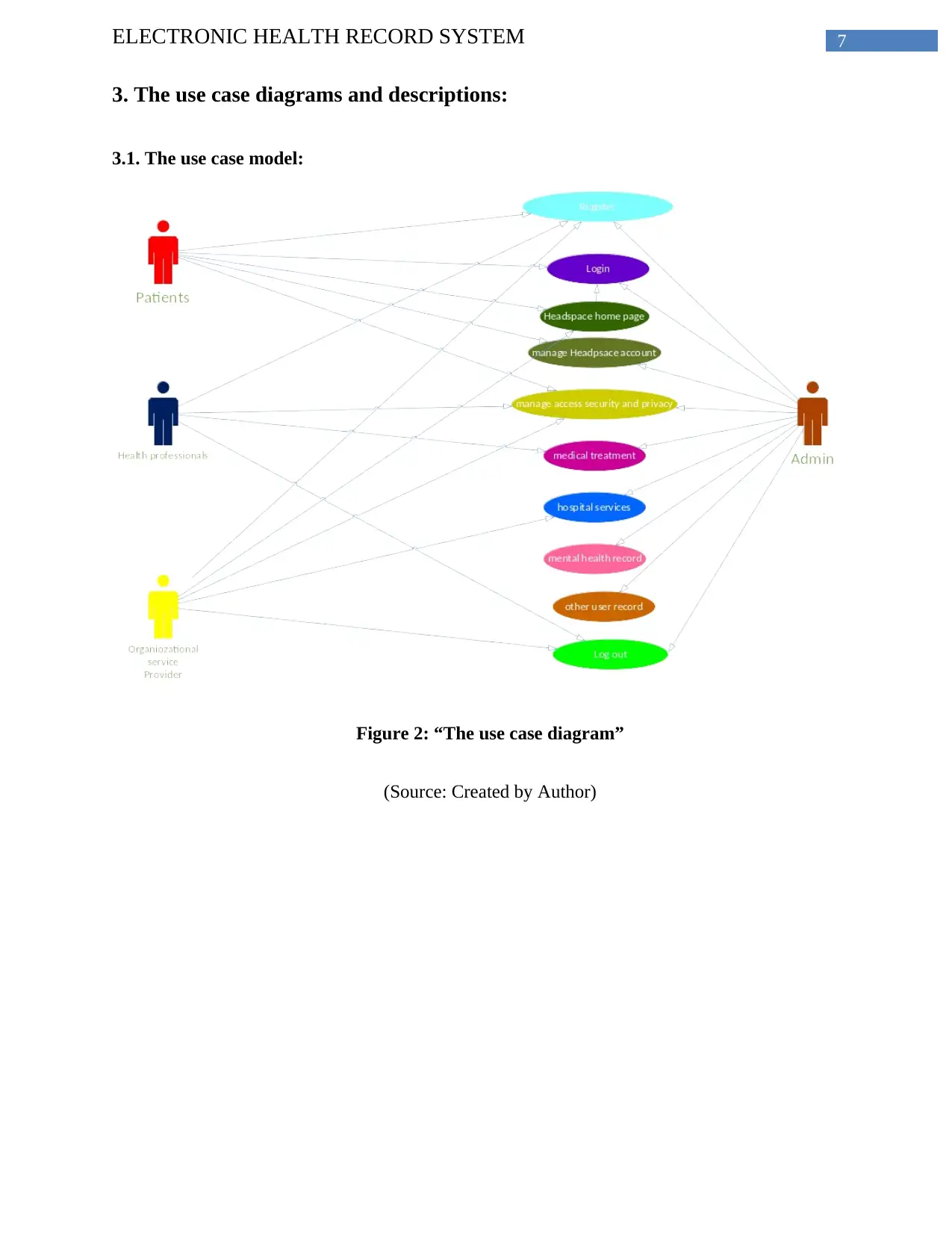
7ELECTRONIC HEALTH RECORD SYSTEM
3. The use case diagrams and descriptions:
3.1. The use case model:
Figure 2: “The use case diagram”
(Source: Created by Author)
3. The use case diagrams and descriptions:
3.1. The use case model:
Figure 2: “The use case diagram”
(Source: Created by Author)

8ELECTRONIC HEALTH RECORD SYSTEM
3.2. Description about every use case:
Description
Actors Patients This contains information regarding the young mental patients.
Organizational
service providers
They are meant to provide the services related to the clinic or the
hospitals (Abdullah & Ibrahim, 2013).
Healthcare
professionals.
They are meant to provide treatment services to every patient.
Admin They are present to manage all type of employees, business functions
stakeholders of business function along with the systems that have
been newly designed.
System
use case
Register They task is to state that all type of users must register first with their
system (Seidl et al., 2015).
Login The user is intended to login for making their access into system for
fetching services.
Headspace home
page
The patient or the user is able to fetch information through using the
above use case.
Managing
Headspace
account
The patient or the user is effectively able to manage the account
(Almutairi et al., 2013).
Managing
privacy, security,
access
This indicates that the user is able to customize or control privacy and
security of their respective individual account.
Medical This indicates that the user is capable of requesting for all type of
3.2. Description about every use case:
Description
Actors Patients This contains information regarding the young mental patients.
Organizational
service providers
They are meant to provide the services related to the clinic or the
hospitals (Abdullah & Ibrahim, 2013).
Healthcare
professionals.
They are meant to provide treatment services to every patient.
Admin They are present to manage all type of employees, business functions
stakeholders of business function along with the systems that have
been newly designed.
System
use case
Register They task is to state that all type of users must register first with their
system (Seidl et al., 2015).
Login The user is intended to login for making their access into system for
fetching services.
Headspace home
page
The patient or the user is able to fetch information through using the
above use case.
Managing
Headspace
account
The patient or the user is effectively able to manage the account
(Almutairi et al., 2013).
Managing
privacy, security,
access
This indicates that the user is able to customize or control privacy and
security of their respective individual account.
Medical This indicates that the user is capable of requesting for all type of
⊘ This is a preview!⊘
Do you want full access?
Subscribe today to unlock all pages.

Trusted by 1+ million students worldwide
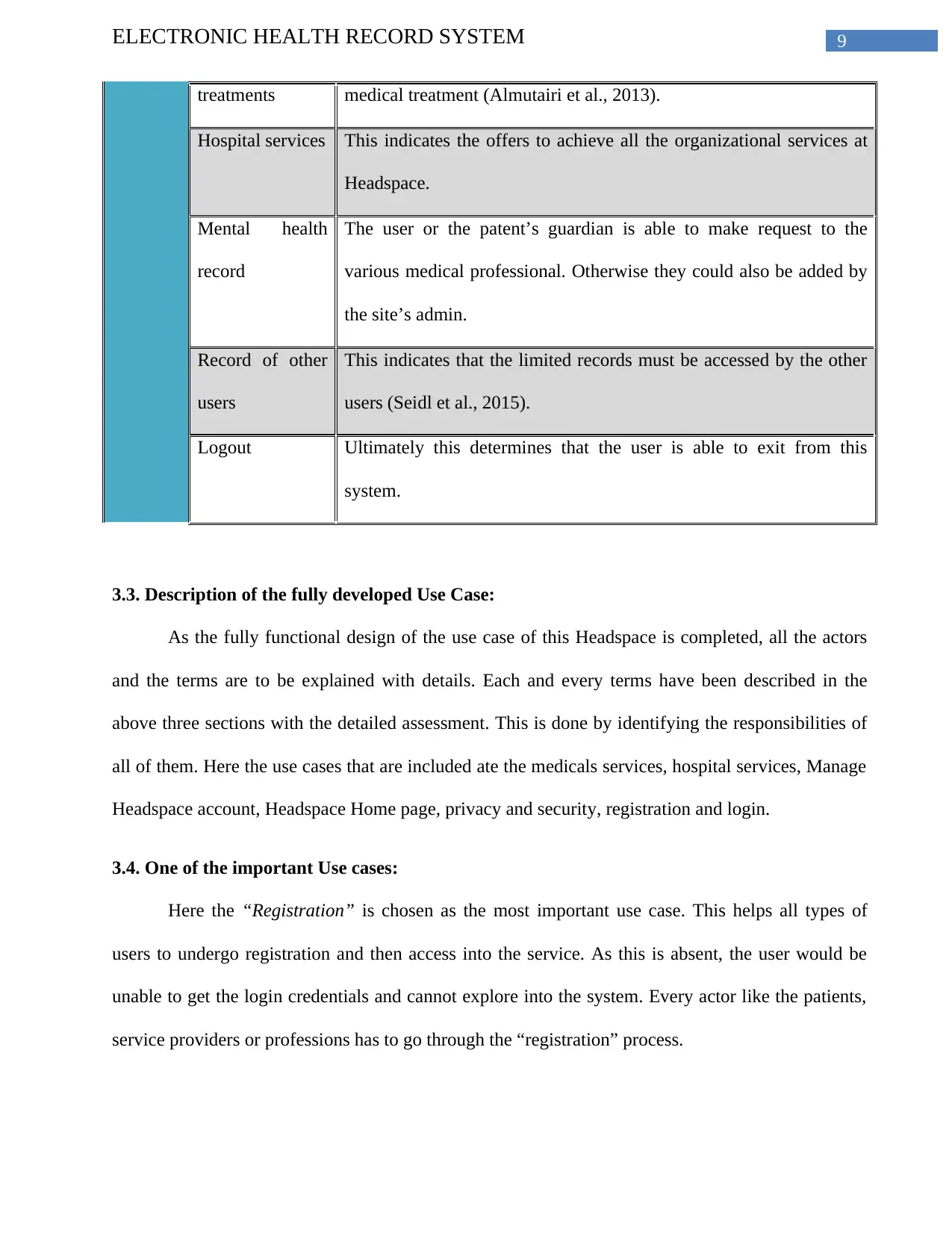
9ELECTRONIC HEALTH RECORD SYSTEM
treatments medical treatment (Almutairi et al., 2013).
Hospital services This indicates the offers to achieve all the organizational services at
Headspace.
Mental health
record
The user or the patent’s guardian is able to make request to the
various medical professional. Otherwise they could also be added by
the site’s admin.
Record of other
users
This indicates that the limited records must be accessed by the other
users (Seidl et al., 2015).
Logout Ultimately this determines that the user is able to exit from this
system.
3.3. Description of the fully developed Use Case:
As the fully functional design of the use case of this Headspace is completed, all the actors
and the terms are to be explained with details. Each and every terms have been described in the
above three sections with the detailed assessment. This is done by identifying the responsibilities of
all of them. Here the use cases that are included ate the medicals services, hospital services, Manage
Headspace account, Headspace Home page, privacy and security, registration and login.
3.4. One of the important Use cases:
Here the “Registration” is chosen as the most important use case. This helps all types of
users to undergo registration and then access into the service. As this is absent, the user would be
unable to get the login credentials and cannot explore into the system. Every actor like the patients,
service providers or professions has to go through the “registration” process.
treatments medical treatment (Almutairi et al., 2013).
Hospital services This indicates the offers to achieve all the organizational services at
Headspace.
Mental health
record
The user or the patent’s guardian is able to make request to the
various medical professional. Otherwise they could also be added by
the site’s admin.
Record of other
users
This indicates that the limited records must be accessed by the other
users (Seidl et al., 2015).
Logout Ultimately this determines that the user is able to exit from this
system.
3.3. Description of the fully developed Use Case:
As the fully functional design of the use case of this Headspace is completed, all the actors
and the terms are to be explained with details. Each and every terms have been described in the
above three sections with the detailed assessment. This is done by identifying the responsibilities of
all of them. Here the use cases that are included ate the medicals services, hospital services, Manage
Headspace account, Headspace Home page, privacy and security, registration and login.
3.4. One of the important Use cases:
Here the “Registration” is chosen as the most important use case. This helps all types of
users to undergo registration and then access into the service. As this is absent, the user would be
unable to get the login credentials and cannot explore into the system. Every actor like the patients,
service providers or professions has to go through the “registration” process.
Paraphrase This Document
Need a fresh take? Get an instant paraphrase of this document with our AI Paraphraser

10ELECTRONIC HEALTH RECORD SYSTEM
Conclusion:
The above stakeholder map with its description balances and weighs all the competing
demands at Headspace and meeting perquisites of the project. The questionnaire helps in identifying
the additional information. This includes the on-goings, issues and the various approaches towards
the system for resolving the challenges. Here the use cases like log-in, log-out and register are
described considering the actors like the patients, service providers and professionals. Ultimately the
“registration” is referred to as the most significant use case. This is because every actor is bound to
undergo through it.
Conclusion:
The above stakeholder map with its description balances and weighs all the competing
demands at Headspace and meeting perquisites of the project. The questionnaire helps in identifying
the additional information. This includes the on-goings, issues and the various approaches towards
the system for resolving the challenges. Here the use cases like log-in, log-out and register are
described considering the actors like the patients, service providers and professionals. Ultimately the
“registration” is referred to as the most significant use case. This is because every actor is bound to
undergo through it.
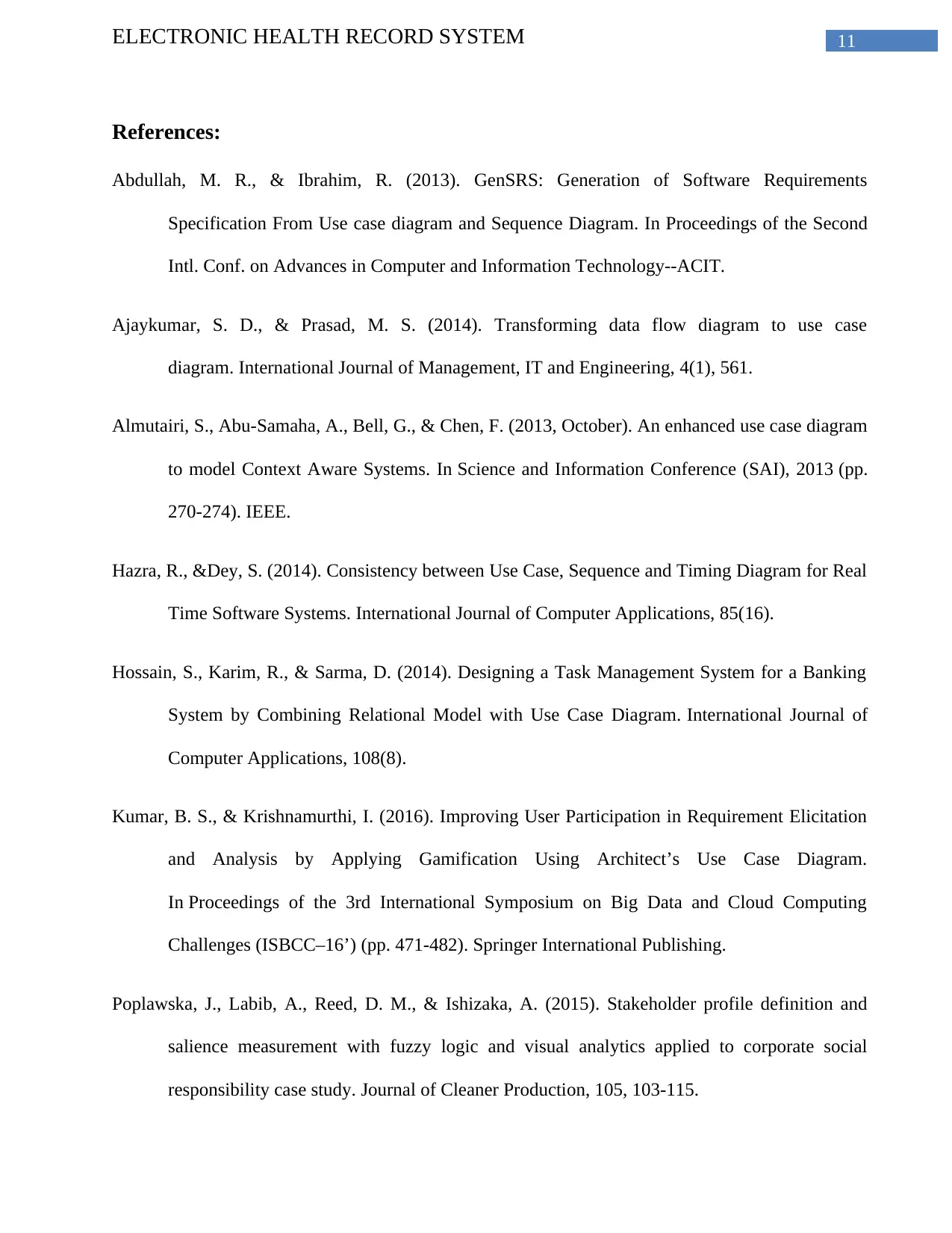
11ELECTRONIC HEALTH RECORD SYSTEM
References:
Abdullah, M. R., & Ibrahim, R. (2013). GenSRS: Generation of Software Requirements
Specification From Use case diagram and Sequence Diagram. In Proceedings of the Second
Intl. Conf. on Advances in Computer and Information Technology--ACIT.
Ajaykumar, S. D., & Prasad, M. S. (2014). Transforming data flow diagram to use case
diagram. International Journal of Management, IT and Engineering, 4(1), 561.
Almutairi, S., Abu-Samaha, A., Bell, G., & Chen, F. (2013, October). An enhanced use case diagram
to model Context Aware Systems. In Science and Information Conference (SAI), 2013 (pp.
270-274). IEEE.
Hazra, R., &Dey, S. (2014). Consistency between Use Case, Sequence and Timing Diagram for Real
Time Software Systems. International Journal of Computer Applications, 85(16).
Hossain, S., Karim, R., & Sarma, D. (2014). Designing a Task Management System for a Banking
System by Combining Relational Model with Use Case Diagram. International Journal of
Computer Applications, 108(8).
Kumar, B. S., & Krishnamurthi, I. (2016). Improving User Participation in Requirement Elicitation
and Analysis by Applying Gamification Using Architect’s Use Case Diagram.
In Proceedings of the 3rd International Symposium on Big Data and Cloud Computing
Challenges (ISBCC–16’) (pp. 471-482). Springer International Publishing.
Poplawska, J., Labib, A., Reed, D. M., & Ishizaka, A. (2015). Stakeholder profile definition and
salience measurement with fuzzy logic and visual analytics applied to corporate social
responsibility case study. Journal of Cleaner Production, 105, 103-115.
References:
Abdullah, M. R., & Ibrahim, R. (2013). GenSRS: Generation of Software Requirements
Specification From Use case diagram and Sequence Diagram. In Proceedings of the Second
Intl. Conf. on Advances in Computer and Information Technology--ACIT.
Ajaykumar, S. D., & Prasad, M. S. (2014). Transforming data flow diagram to use case
diagram. International Journal of Management, IT and Engineering, 4(1), 561.
Almutairi, S., Abu-Samaha, A., Bell, G., & Chen, F. (2013, October). An enhanced use case diagram
to model Context Aware Systems. In Science and Information Conference (SAI), 2013 (pp.
270-274). IEEE.
Hazra, R., &Dey, S. (2014). Consistency between Use Case, Sequence and Timing Diagram for Real
Time Software Systems. International Journal of Computer Applications, 85(16).
Hossain, S., Karim, R., & Sarma, D. (2014). Designing a Task Management System for a Banking
System by Combining Relational Model with Use Case Diagram. International Journal of
Computer Applications, 108(8).
Kumar, B. S., & Krishnamurthi, I. (2016). Improving User Participation in Requirement Elicitation
and Analysis by Applying Gamification Using Architect’s Use Case Diagram.
In Proceedings of the 3rd International Symposium on Big Data and Cloud Computing
Challenges (ISBCC–16’) (pp. 471-482). Springer International Publishing.
Poplawska, J., Labib, A., Reed, D. M., & Ishizaka, A. (2015). Stakeholder profile definition and
salience measurement with fuzzy logic and visual analytics applied to corporate social
responsibility case study. Journal of Cleaner Production, 105, 103-115.
⊘ This is a preview!⊘
Do you want full access?
Subscribe today to unlock all pages.

Trusted by 1+ million students worldwide
1 out of 12
Related Documents
Your All-in-One AI-Powered Toolkit for Academic Success.
+13062052269
info@desklib.com
Available 24*7 on WhatsApp / Email
![[object Object]](/_next/static/media/star-bottom.7253800d.svg)
Unlock your academic potential
Copyright © 2020–2025 A2Z Services. All Rights Reserved. Developed and managed by ZUCOL.




